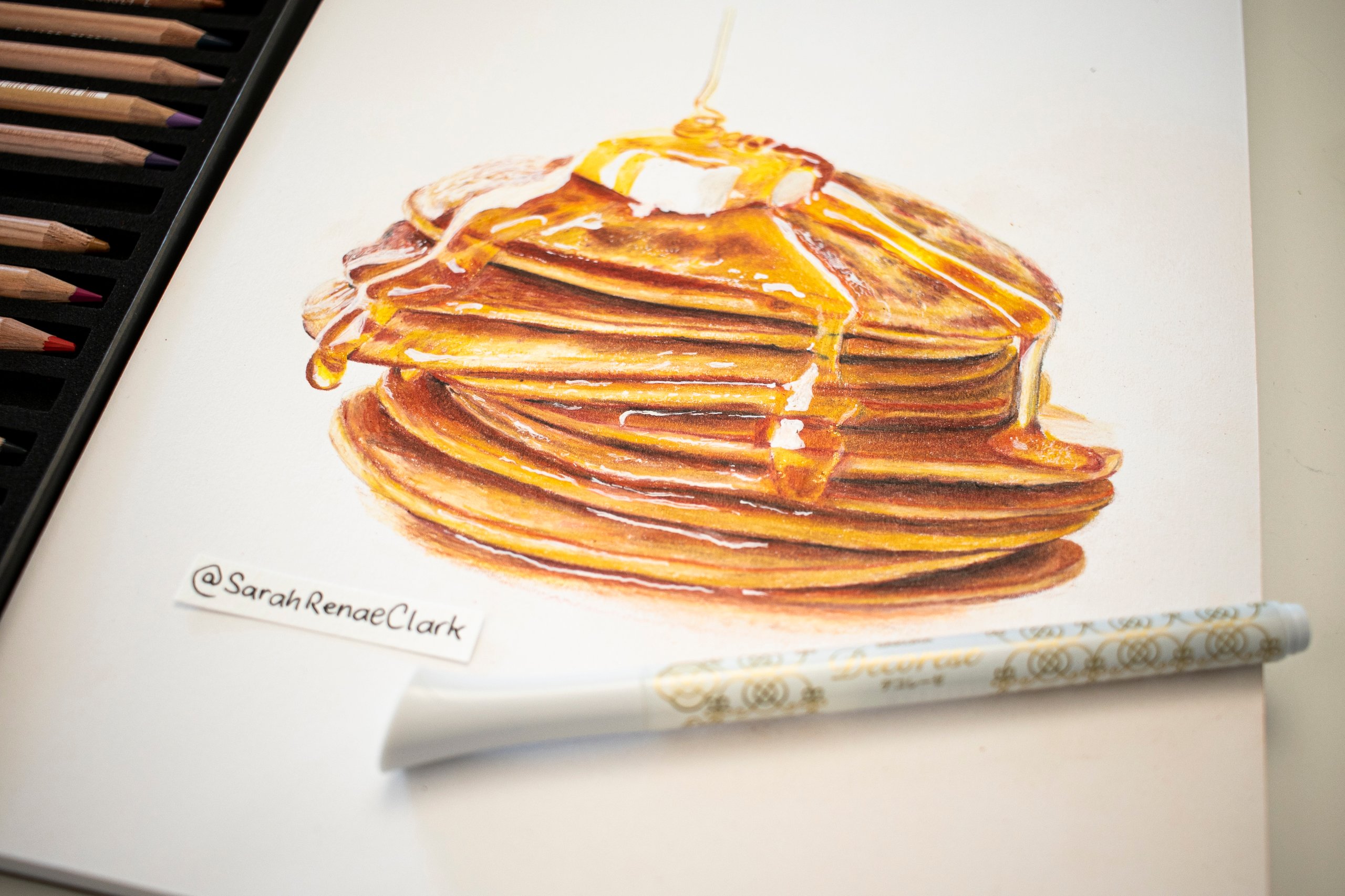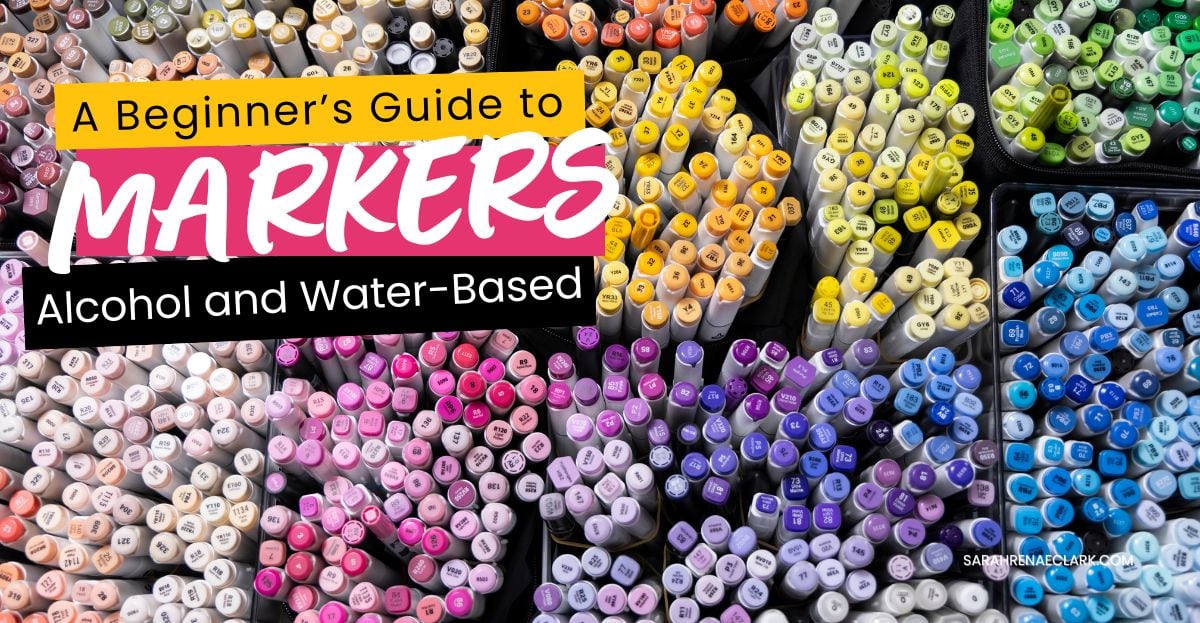I’ve already tested over 60 different white pens to find the BEST white pen in the world (spoiler: it wasn’t Posca, but they were pretty good too) and now I want to provide you with my BEST tips for using white pens for drawing and coloring, no matter what medium you are using.
But first, check out my video on YouTube where I tested over 60 White Pens to find out which one was the ultimate best.
Some new brands performed impressively, and some trusted brands did not live up to the hype for me. SEE THE INDIVIDUAL RESULTS HERE.
PLEASE NOTE: This post contains affiliate links, and I may earn a commission if you click them (at no cost to you). The Artistro, Life of Colour and Chalkola paint pens were given to me by the brands over a year ago. I am no longer associated with these brands, and they were not aware of, or involved in this review. I have personally purchased all of the other pens/inks/markers used in this review.
Other Articles in this Series

Part 1: Testing Every White Pen
See the results of every test, as I performed it and what I discovered along the way!

Part 2: Ultimate White Pen Shopping Guide
I’ve included a breakdown of every single white pen I tested, with detailed descriptions, rankings, individual results and details of where to buy your favorites.

Part 3: How to Use White Pens
You are here! Scroll down to keep reading.
What are White Pens Used For?
- Using White Pens for Highlights
- Using White Pens to Create Textures
- Using White Pens for Mixed Media
- Using White Pens for Lettering
- Using White Pens for Watercolor Art
- Using White Pens to Fix Mistakes
- Other Ideas for White Pens
Tips for Using a White Pen
- Which White Pens to Buy
- Test Your Pens Before Using Them
- Use Light Pressure
- Allow the Ink to Dry
- Add Multiple Layers
- Make a Copy of Your Art
- Keep it Simple
- Experiment!
Answering your questions About White Pens!
- How do you clean white pens?
- How do you store white pens?
- How do I stop my white pen from clogging?
- Can I use a white pen on top of pencils, watercolors, paints, acrylics and markers?
- Is white-out a good alternative to a white pen?
- Are white gel pens better than white acrylic markers?
- How can I stop my white pen from turning pink?
- What are the brightest white pens?
- Why isn’t my white pen as vibrant as I expected?
What are White Pens Used For?
White pens can really elevate your artwork from good to great, and are a must-have tool for every artist or crafter. They are useful for adding highlights and details to all kinds of art projects, for adding lettering or messages to cards, for cardmaking, mixed media, to create contrast in manga art, and even to correct mistakes with other media.
Using White Pens for Highlights
A white pen is a great way to add highlights to any kind of art. You can add shiny highlights to things like glass, water droplets or bubbles to make them look translucent.
You can add sparkles, stars, outlines, patterns, or any kinds of highlights – either going for a realistic style (following a light source) or just experimenting with color and shape.
Using a white pen for outlines or edges can help create depth in your art. Outlining objects in your work can help to make it pop out from the background and give it a 3D look.
In this galaxy coloring page, I used the white marker to outline the edge of the planet, giving it the appearance of the sun bursting from behind.



White pens are excellent for adding the effect of sparkles and glimmers to jewellery and gemstones in your art piece. Imagine the light source hitting your gem and creating a blinding sparkle and this is where you’d add your highlights.
Using White Pens to Create Textures
Layering or feathering your white pen over colored pencils or markers can give great effects and textures. You can use your pen to create fur or hair, or use methods like stippling, cross-hatching and scumbling to create a huge variety of textures.
Try different tip sizes to see the different effects you can achieve.


Using White Pens for Mixed Media
A white pen is invaluable for mixed media artists. Depending on the type of pen you are using, many pens work well with markers, pencils or watercolors and can be used to add highlights, textures or or details.
It can be particularly interesting to layer white pens with translucent papers and paints, or use it as a resist technique for watercolor! Test your pens to see which ones will work for this before using them on your final project.
Using White Pens for Lettering
White pens look amazing when used for calligraphy or lettering on cards or artwork! It’s best to make sure your white pen is flowing smoothly before you try this, so use a scrap piece of paper to get it working first, and choose a pen with a good opacity (I’ve compared them all here)
Using White Pens for Watercolor Art
Because watercolor is often such a loose medium, a white pen can create a striking contrast with details and outlines, or added textures and lettering. Some white pens will also allow you to create a resist technique if you apply them first, but you should test this beforehand.
It’s best to make sure your watercolor is completely dry before doing any white pen details, and always test how your media works together before working on your final projects!
Using White Pens to Fix Mistakes
If you’ve ever accidentally colored outside the lines, a white pen can help! Sometimes there are other ways to hide or embrace our mistakes, but sometimes a white pen is the perfect fix to hide a little slip-up of your markers or pencils. Again though, it’s best to test it elsewhere first to make sure it doesn’t interact with your other supplies and make an even bigger mess!
If you’ve made a mistake WITH your white pen, give it a moment to dry and you can usually scratch it off or color over it again with other supplies.
Other Ideas for White Pens
Want to take your portraits and skin tone coloring to the next level? White pens can definitely help. Whether you’re aiming for realism or whimsical, use your white paint or gel pens to add bright highlights to eyes, a little twinkle or a bright light source highlight.
Theres not too many things you can’t do with your white pens; it’s really only limited by your own creativity. I often use white paint pens for highlights on my art but also consider glitter, stars, accents, eyes as just a few jumping off points for you to enhance your work with a white pen.

I used white pens on this Little Mermaid coloring page in the Thomas Kinkade Disney Dreams coloring book to create the texture of the waves and sea spray, providing more depth and movement to the artwork.

Little dots of white paint pen and highlights added a beautiful finish and a little whimsy to this Johanna Basford coloring page.

White spots across the plant life in this coloring book by Hanna Karlzon created an interesting texture as well as a little twinkle in her eye!
Tips for Using a White Pen
With all these ideas… now what? I want to share with you everything I’ve learned about choosing, testing and using your white pen for your coloring pages and beyond.
Which White Pens to Buy
There are SO many white pens available online, and the reviews don’t make it any easier to narrow down the right one.
So I’ve tried to help by buying them all and testing them for you! You can see my video and the results in Part One of this series.
Here are some things I tested that you might consider:
- Opacity: How bright is the pen? Is it completely opaque or is it transparent, and which is important for your project? I compared the brightest and most opaque pens here.
- Flow Consistency: White gel pens can start “railroading” or skipping, and this can be frustrating when you are trying to create a smooth line. White paint pens are usually more consistent, but the wrong pen can be blotchy or let out too much paint. I compared the flow and consistency in all the pens I tested.
- White Pen Type: White pens come in different types, the most popular being a white ball-point gel pen or a white acrylic marker. You can also buy white india ink or white ink pots, along with other types of white inks and markers. You may wish to try a few types to find the best for your project.
- Tip Size: White gel pens are usually smaller (ranging from fine to super-fine), but white acrylic markers come in a variety of sizes from fine to large tips. Some artists like to have a few sizes to cater to different projects. I find a fine tip like the Artistro white paint pen is a good starting point.
- Tip Type: The type of nip will affect how you use your pen. Gel pens are usually a ball-point tip, so keeping this moving will help with blockages. Fine-point paint pens often have a plastic tip, which requires a softer touch so it doesn’t get bent or start spraying paint. Larger paint pens are often a felt tip, which is softer on the paper and my personal
- Compatibility with other media: Not all pens work with all media. Some pens work great on markers, but terrible on pencils. Your media makes a difference to which pen is right for you. See my tests to which pens I recommend for different media.
- Refillability: Not many pens offer refillability, but if this is important to you, it’s best to research this before you commit to a brand. Refillable pens will usually come at a higher price initially, but refills will make it more affordable over time.
- Price: The most expensive white pens aren’t necessarily the best! But you do get what you pay for, and buying the cheapest white pen might leave you disappointed (and you’ll end up spending more to re-buy more pens to replace them) so it’s worth looking around. I found quite a few good pens that were affordable and ranked in my top recommendations for best white pens!
Test Your Pens Before Using Them
Testing your white pen on scrap or draft paper before you start to use it on your art is so so important. In some cases, like with paint markers, priming your pen on scrap paper lets the flow begin without splotching on your artwork. It also gives you a clearer understanding of how to use your pen for the best effect, especially if it’s a new one!

Use Light Pressure
White pens tend to work better when you’re gentle. To get the boldest lights and the most vibrant effect, I work in small sections and with a light pressure. This patient approach will give you more consistent results.
Allow the Ink to Dry
Being patient with your work will pay dividends! By allowing your work to dry and then allowing each layer of the white ink to dry, you can prevent smudges on your art. This tip also allows for you to add layers to your work, reassessing between each layer to see what your work really needs.
Add Multiple Layers
If you’re looking to create a really bright highlight, let your first layer of ink / paint dry completely and then go over it again with a second layer of white. Each layer will add intensity to the section you’re working on, giving a brighter effect each time you do it. Keep in mind that there will be a limit to the number of layers you can apply, depending on the surface you’re working on.

Make a Copy of Your Art
Not quite sure where you want your highlights yet? That’s okay! Make a copy of your work either with a photocopier or take a photo with your phone/iPad and use a digital art app to practice. This way you can experiment with light sources, highlights and shadows and see really clearly where your white pen effects will work best.
Keep it Simple
This is a tip that I should take on board more often, but use your white pen and highlights sparingly! When you’re working in small sections, make sure to take time to stop and assess both each section and your artwork as a whole so you can see how well you’re highlights are working. It IS possible to overwhelm your artwork. (Even though I constantly say “you can never have too many highlights!”)
Experiment!
As with anything in art, there are no rules! Try different strokes and techniques, get creative, and see where the canvas takes you!

Answering your questions About White Pens!
How do you clean white pens?
Sometimes certain white pens will clog up or dry out, but this doesn’t mean your journey with your white highlights is over! The best way to clean a white pen will depend on the type of pen you’re using but I’ve had success extending the life of my pens by simply cleaning the nib with a soft cloth, warm water, steam or even rubbing alcohol (for gel pens). These methods will help clean the nib and restore your smooth ink flow.


If you’re using a paint pen that has completely dried up, you can remove the nib and soak it in warm water for a few hours to remove the dried paint.
How do you store white pens?
It’s best to store your pen laying down (horizontally), not standing up. This will stop the paint or ink from settling at one end or clogging up the tip. Always be sure to keep your pen lid on tightly when not in use. Keep your paint pens, gel pens and other art supplies in a cool, dry place away from sunlight or extreme temperatures.

How do I stop my white pen from clogging?
Clogging can happen with all types of white pens, but proper storage and use can help minimize or prevent it.
Avoid pressing too hard while using your pen, and use the scrap paper test to “clean” any debris from your pen before and after using it on different media.
Using your white pens regularly (even for a short test) can help them to work better than if you leave them for long periods of time in storage. Ink or paint can dry or clog if left unused for a long period of time.
If you’re using a white acrylic paint pen, try not to over-pump it with paint, or you may create a clog. You can wipe excess paint away with a tissue or soft cloth before replacing the cap to help reduce the change of dried paint clogging the tip when it’s in storage.
If you’re using a gel pen, try not to shake or drop it, as this may create air bubbles that can cause skipping and disrupt the ink flow. It’s very hard to remove air bubbles once they occur.
Can I use a white pen on top of pencils, watercolors, paints, acrylics and markers?
Yes! White pens can be used on many different types of mediums, but not all pens work the same on each. You can see my tests here.
Here are some general tips to keep in mind:
- Watercolor: Make sure your art is completely dry before applying your white pen.
- Paints: as with watercolor, make sure your art is dry.
- Colored pencils: Wax-based pencils may damage white gel pens, so acrylic pens are generally better. Either way, clean your white pen regularly when working with pencils.
- Markers: Most markers work well as a base for white pens. Some colors tend to absorb the white pen and it is difficult to create an opaque white (it turns pink!) so this is worth testing before working on your art.

Is white-out a good alternative to a white pen?
Correction fluid or “white-out” products serve a different purpose, but are often used as an alternative to white pens. In my experience, they aren’t necessarily cheaper and are thicker and often textured, making them difficult to work with. Proper white pens are more suitable for art, because they have a smoother ink flow and allow for finer details.
While it might work as a quick makeshift alternative in the moment, it’s not something I’d recommend overall. Especially with the huge availability of affordable white pens now.
Are white gel pens better than white acrylic markers?
Both white gel pens and white acrylic pens have their pros and cons. Generally, gel pens will allow a much smaller tip for precise details, and there are some great options for a really bright white.
But from all the pens I tested, the white acrylic pens were more versatile overall. There were still some options that offered a fine point (although not as fine as a gel pen) and they worked better on surfaces like colored pencils, which is a medium I use more than others. I wish I tried the acrylic markers sooner.
If you’re unsure, try a few of both and see what you think!

How can I stop my white pen from turning pink?
During my white pen testing, I noticed that every single pen was changing color when I used it on certain pencils and markers. This is an issue that I know many artists struggle with, so much so that I’ve seen reviews on Amazon giving a 1-star review on pens because they turned pink.
But as it turns out – this is not a problem specific to a brand. This happens to EVERY white pen when used on certain colors – especially reds, purples and blues.
I tested this on 8 different types of paper with various media and the issue occurred every time.
Both the fixative and gesso worked to reduce the pink on most of the colors I sampled, but the most notorious Prismacolor PC931 still changed the white Posca marker to pink.
I did find ONE product that didn’t change color, and that was the Dr Ph Martin Pen-White. It didn’t work well on all surfaces in my other tests, but it’s the only product that was a true white in this test.
The good news is that the color changing problem doesn’t happen for most colors anyway, so this isn’t something you’ll need to worry about often.

What are the brightest white pens?
I tested 61 white gel pens, paint pens and inks, and these were the brightest whites:
- Artline Laundry Marker (28)
- Sakura Gelly Roll – Bold (43)
- Uni-Ball Signo Broad Gel Pen (49)
- Ph. Martin’s Pen – White Ink (53)
- Arteza Gel Pens (56, 57, 58)
- Sharpie Water-Based Paint Marker (18)
- Kuretake Zig White Drawing Ink (54)
- PaperMate Liquid Paper (30)
- Uni Posca Markers (12, 13, 10)
- Deleter Neopiko (15)

Why isn’t my white pen as vibrant as I expected?
First, check that you’ve chosen a pen with the best opacity. I tested them here. If you’re using a white paint pen, it’s possible that you haven’t mixed the paint inside the pen enough. Put the lid on firmly and give it a really good shake. It’s also possible that your paper or media is absorbing the white ink, so try the white pen on another surface to see if you get the same result.
What Will you Create With White Pens?
Whether you’re using a white pen to add realistic details to a face or to add patterns to a coloring page, both a white gel pen or a white paint pen are a great tool for any artist to add to their kit!
I hope you’ve picked up some new ideas, and I’d love to hear your further thoughts and questions in the comments or in my Facebook Group.
To explore all the testing I did, or find the best white pen to buy, please check out Part 1 and Part 2 of this white pen series!

Part 1: Testing Every White Pen
See the results of every test, as I performed it and what I discovered along the way!

Part 2: Ultimate White Pen Shopping Guide
I’ve included a breakdown of every single white pen I tested, with detailed descriptions, rankings, individual results and details of where to buy your favorites.





















Thank you so very much for this time saver test on the white pens. Unfortunately this has been the problem for me with the white gel pens of a couple of brands because yes I have prisma pencils and I am slowly changing my pencil types over. Thank so very much Sarah